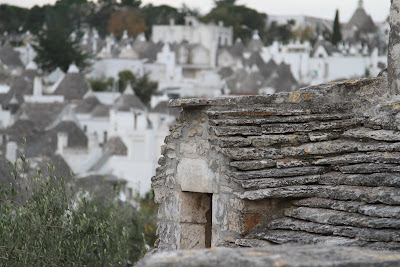
Alberobello (beautiful tree in Italian) is a small town in Puglia, Italy. The historic part of Alberobello and its characteristic trulli structures (singular trullo) are a UNESCO World Heritage site. The trulli are limestone dwellings that are examples of mortarless construction where limestone slabs are fitted again into walls and pyramidal, domed or conical roofs. Often the roofs have large markings on them that are a mix of Christian, pagan, and magical symbols. Before coming to Alberobello we heard that the people were forced to settle the land and the stones were all they could build with. In the regional museum, one of the informational signs stated that a local lord required the trulli to be built without mortar because it avoided taxes, there being taxes only on permanent structures. Not sure what the truth is here. For details on the how trulli are built see this informative site.
We stayed in a trullo operated by Trullidea.it. The trullo is called the chimney and it was just a bit above the “tourist” zone, though at this time of the year the tourist pressure was very light. The way breakfast works at Trullidea.it works is that you get a coupon for a coffee and cornetto (croissant) at Bar Aldo (which is really called Bar Piper and it is on Via Morea/Indipenza just before you reach Via Don F. Gigante as you walk west). We purchased breakfast supplies for the five days we were there and stored them in the little kitchen in our trullo. We ate in our trullo and then headed down to Aldo. There is a regular market and a special Thursday morning market where you can pick up all sorts of goodies to eat.
The regional museum (Museo del Territorio) located in Piazza Maggio is worth a look. It’s not very big but gives you an idea of the history of the trulli if you don’t know already. The museum is where we learned about the Antico Frantoio Oleario Intini. We got a little tour from owner Pietro (the son) and sampled a few oils, in particular olio nuovo. We ordered our goodies on one day and picked them up the next day. It was a very pleasant experience. Intini is located just on the edge of town and is worth a visit if you want to take some olive oil back with you. We had it put in small tins that we packed in our luggage. It survived the flight back.
On our way to Alberobello from the Naples area we stopped for lunch in Ruvo di Puglia at a restaurant called, an acronym that’s a mouthful, U.P.E.P.I.D.D.E. (unico post esclusivo per individui di doppia esigenza). It was a fabulous lunch place. Great service and tastes. And, you can buy wine from the cantina. We only saw Ruvo di Puglia a little before and after lunch, but, it looks like it would merit a return. Speaking of restaurants we also tried the formal Ristorante Il Poeta Contadino and the less formal Ristorante La Cantina di Lippolis in Alberobello. Both were good. But if you are trying to keep your meal cost down, choose La Cantina.
We based our stay out of Alberobello and did several day trips to Grotte di Castellana and Monopoli, Sassi di Matera, Torre Guaceto, and Ostuni. This was our first time in the area. It worked out fairly well as a base of operations, naturally, with a car. Alberobello is easy to get in and out of and the town has charming feel. If we were to come again, we would consider Ostuni as a base of operation for something different.
Morning in Alberobello

Trulli Roof Symbols


The Trullo Zone

Trullo Roof Detail

Trullo Spire Design

I was there in the last year. The trullis are impressive indeed. We also stayed overnight in one of them. Thank you for the good collection of symbols. As far as I know, some of them are christian and some are pagan.
ReplyDeleteJulius